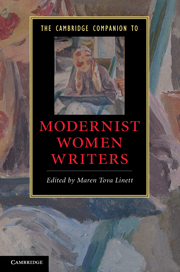Book contents
- Frontmatter
- Modernist women’s literature: an introduction
- 1 Transforming the novel
- 2 Modernist women poets and the problem of form
- 3 Women’s modernism and performance
- 4 Magazines, presses, and salons in women’s modernism
- 5 Gender in women’s modernism
- 6 Black women’s modernist literature
- 7 Race and ethnicity in white women’s modernist literature
- 8 Geomodernism, postcoloniality, and women’s writing
- 9 Women modernists and visual culture
- 10 Modernism and trauma
- 11 Political activism and women’s modernism
- 12 Religion and the occult in women’s modernism
- Guide to further reading
- Index
9 - Women modernists and visual culture
Published online by Cambridge University Press: 28 November 2010
- Frontmatter
- Modernist women’s literature: an introduction
- 1 Transforming the novel
- 2 Modernist women poets and the problem of form
- 3 Women’s modernism and performance
- 4 Magazines, presses, and salons in women’s modernism
- 5 Gender in women’s modernism
- 6 Black women’s modernist literature
- 7 Race and ethnicity in white women’s modernist literature
- 8 Geomodernism, postcoloniality, and women’s writing
- 9 Women modernists and visual culture
- 10 Modernism and trauma
- 11 Political activism and women’s modernism
- 12 Religion and the occult in women’s modernism
- Guide to further reading
- Index
Summary
As Ann Ardis argues, the New Woman is the key figure in turn-of-the-twentieth-century debates about gender, visual cultures, and modernity. Changes in gender relations, from 1882 - the year of Virginia Woolf's birth - to the 1920s, interact with the development of modernism. Women were central players in new city spaces as suffragettes and in novelists' newly imagined public modernities, for example in Dorothy Richardson's Pilgrimage. Women's experiences of urban modernity included the spheres of art galleries and cinemas which offered new modes of collective seeing. Women artists and art critics were highly visible in, and major contributors to, London journals. By the turn of the century, there were over thirty women critics contributing signed articles with some, for example the writer Alice Meynell, earning over £400 a year. In turn, twentieth-century women's modernism is obsessed with issues of visuality. Women modernists, including Virginia Woolf and her sister the artist Vanessa Bell, were also the first generation of women to be active photographers and cinema-goers from childhood. Like Bell, many women painters were photographers. For example, the American artist Susan Sears began photography at the same time as she was exhibiting paintings, and she joined Alfred Stieglitz's Photo-Secession in 1904.
- Type
- Chapter
- Information
- The Cambridge Companion to Modernist Women Writers , pp. 146 - 159Publisher: Cambridge University PressPrint publication year: 2010
- 1
- Cited by



